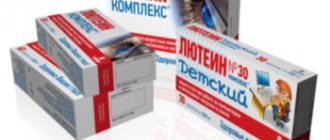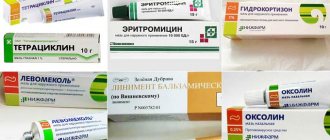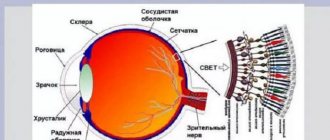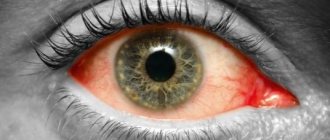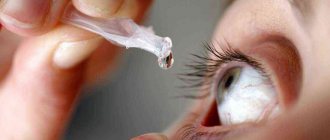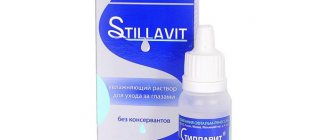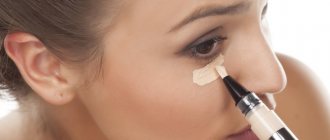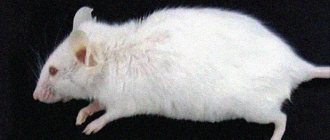What is myopia?
People suffering from myopia have trouble seeing objects located far from them, but they can see well up close. This is due to the fact that light rays that are refracted in the visual system do not fall on the retina, as happens with normal
In this article
- What is myopia?
- Restoring vision in myopia: medication method
- Types of medications that help improve vision
- Eye drops
- The most effective drops for restoring vision in myopia
- Preparations for restoring vision: complexes of useful substances
- Tablets to improve vision for myopia
- Solutions and drops for the treatment of myopia
- Rules for the use of drops and solutions for the treatment of myopia
conditions, and in front of her. The eyeball, under the influence of certain factors, becomes enlarged and elongated, and the ability to accommodate decreases. Ophthalmologists measure the degree of refractive pathologies in diopters. If a patient is diagnosed with myopia, a “-” sign appears before the optical power indicator after vision diagnosis (for farsightedness “+”). It is important to know that the worse a person’s vision, the more serious the severity of the disease. There are three degrees of myopia:
- Weak - up to -3 diopters. There is an increase in the eyeball by 1-2 mm. A person cannot distinguish the outlines of objects and inscriptions at a distance of 10 m;
- Average - from -3.25 to -6 diopters. The eyeball lengthens by 3-3.5 mm. It becomes difficult for a person to navigate in space without vision-correcting means; he can clearly distinguish only those objects that are no further than arm’s length.
- High - over - 6 diopters. The anteroposterior axis of the eyeball is excessively enlarged, and therefore problems may arise in the circulatory system of the eyes, the walls of blood vessels become weak and thin, and degenerative changes in the visual apparatus are observed. A person sees objects at a distance of 5-10 cm from the face.
Only after a comprehensive examination of the patient’s vision will a specialist be able to determine the severity of the pathology and, based on the data obtained and the person’s lifestyle, prescribe treatment for myopia.
What you need to know about farsightedness
Farsightedness (hyperopia) is common if a person is over 40 years old. The aging process affects all systems of the body, and in the visual system this phenomenon is expressed in presbyopia (age-related farsightedness). After 40, the eye structures lose elasticity and can no longer quickly and fully perform their functions. To stop these processes, ophthalmologists prescribe special drops.
You should refrain from self-medication. The doctor should prescribe the drops, taking into account the patient’s age, features of farsightedness, concomitant diseases, lifestyle and contraindications. The goal of therapy is to minimize eye strain, slow down the progression of the disease, and prevent complications.
Often, spectacle correction does not help the patient get rid of visual discomfort. Even with stabilization of visual function, dryness, burning and discomfort remain, which can be eliminated with the help of drops. Drug therapy is necessary to improve the visual function of farsighted eyes.
For hypermetropia, different drops can be prescribed: anti-inflammatory, vitamin, artificial tears and others. The choice depends on the needs of the individual patient.
Restoring vision in myopia: medication method
It is necessary to understand that vision tablets, drops and other medications are auxiliary means of treating the disease. This is due to the fact that eye medications do not affect the restoration of the lens and change the shape of the cornea. Most often, certain drops and medications are prescribed to stabilize vision by activating the nutrition of the visual system. In addition, experts strongly recommend undergoing a course of treatment for myopia 1-2 times a year using the best, high-quality medications. The ophthalmologist can select them only after diagnosing vision and talking with the patient. The doctor will write a prescription and give important recommendations on the frequency and dosage of taking medications.
Types of medications that help improve vision
Ophthalmologists distinguish three groups of drugs that help treat myopia:
- Drugs that artificially relax the eye muscles. One of the most famous is Atropine.
- Medicines that provide relaxation of the eyes during sleep, for example, Shtulna drops. Medicines of this type are indicated for people who are regularly exposed to heavy loads: prolonged work at the computer, reading, working with small objects.
- Drugs aimed at improving the condition of the retina. As a rule, these are antioxidants of plant origin. For example, vitamins “Aevit” and “Triovit”, “Myrtilene forte”. Multivitamins are especially useful for restoring poor vision, which contain trace elements such as calcium and zinc, as well as medicine containing blueberries (“Blueberry forte”, “Phytoblueberry”). These medications improve blood circulation in the eyes, restore the visual pigment - rhodopsin, and help get rid of retinal muscle dystrophy.
In addition, to prevent the progression of myopia and treat it, the ophthalmologist can prescribe drugs that improve hemodynamics. Thus, patients with a mild form of myopia are advised to take nicotinic and ascorbic acids, for example, “Halidor”. With a high degree of myopia, more potent drugs that have a vasodilating effect are required - Trental and Nigexin.
Drops for myopia for children
A significant number of drops for the treatment of myopia are prohibited for use by children. Still, there are drugs that can be instilled into children's eyes. Some of them are introduced only under medical supervision.
We recommend reading: How to put drops in a child’s eyes
The most common means used for children are:
- Irifrin is an effective remedy for preventing the development of false myopia. It is allowed to be used from the age of 12 under the supervision of an ophthalmologist.
- Taufon is a drug that improves the nutrition of eye tissue. It can be given to small children under the supervision of an ophthalmologist.
- Emoxipine can only be used with the permission of a pediatrician.
- Visioned is prescribed to children from 3 years of age. These are drops with plant extracts containing vitamins that are beneficial for the eyes. Strengthens the retina and restores vision.
Eye drops
In ophthalmology, it is customary to classify eye drops as topical medications. Treatment of myopia occurs with the help of vitamin solutions containing active components of targeted action. This or that medicine of this type helps improve metabolic processes in the eye tissues, reduces the progression of myopia, and stabilizes the pathological process.
It is important to understand that any drops are medications, so their use without the prescription of an ophthalmologist is strictly not recommended.
Almost all drops that provide treatment for different degrees of myopia are produced in tightly closed bottles equipped with a dispensing pipette, which makes their use as convenient as possible.
The user needs to know that once bottles of medications are opened, they will have a limited shelf life. Therefore, before using them, you should study the instructions in detail.
If discomfort occurs when using drops to improve vision, you should stop using them and consult a doctor immediately.
Types of eye drops
Eye drops for myopia are a rather relative concept. It is certainly impossible to cure true myopia with solutions alone. However, they can relieve accompanying symptoms, remove spasm of the ciliary muscle, improve the physiological state and activate the functioning of the organ of vision.
There are several types of drops, all of which can be prescribed for myopia in certain situations.
Among them:
- Antibacterial. Contains antibiotics. They are used for inflammatory diseases of the visual organs caused by bacterial infection, and in the complex therapy of viral eye diseases. One of these drugs is Albucid.
- Moisturizing. They are prescribed for insufficient production of tear fluid, dryness, and redness of the eyes. By moisturizing the cornea, they relieve pain and eye fatigue. Often prescribed to people who spend long hours at the computer and those who wear contact lenses due to myopia. Among them are Systane and others.
- Adrenergic blockers. The mechanism of action is based on reducing the amount of intraocular fluid produced by the organ of vision - for example, the drug "Fotil". This group also includes drugs that improve the outflow of fluid inside the eye - for example, Travatan, as well as drugs that combine both actions. Prescribed for glaucoma and some other conditions.
- Vasoconstrictors. They contain substances that narrow the lumen of the blood vessels of the eye. One of the most popular products in this series is Vizin. The effect of the drug is not only to relieve redness of the eyes: it is prescribed as a component of the treatment of inflammatory diseases. The use of such drugs is subject to strict restrictions on the duration of use.
Treatment with vasoconstrictor drugs should not last more than 5 days, otherwise the eye vessels become accustomed and have the opposite effect.
- Vitamin. These preparations contain substances necessary for the eyes - vitamins (A, C, B1, 2, 6, 12, E), which improve metabolic processes in the tissues of the eye, nourish it, and fight degenerative phenomena. Such medicines include Taufon.
- Anti-inflammatory. They act not so much on the cause of inflammation, like antibacterial drugs, but on the inflammatory process itself, suppressing it. They can be hormonal (steroidal - for example, Dexamethasone) and non-hormonal (non-steroidal - for example, Indocollir).
- Antiallergic. Myopia can be combined with allergies, although these conditions are not directly related. But in this case it is necessary to use antiallergic drugs - for example, Allergodil.
- Mydriatics. These are potent drugs that relieve spasm of the ciliary muscle - false myopia. These include "Atropine". This is a strictly prescription drug with serious potentially toxic effects, so its use must be supervised by a doctor.
See how to properly use the drops in the photo:
The most effective drops for restoring vision in myopia
When a patient has a mild form of myopia, specialists often prescribe the drug Taufon. It contains taurine, which has a regenerative function. With its use, improvements are observed due to the acceleration of metabolic processes and the supply of the optimal amount of oxygen for the proper functioning of the visual system. No less popular are Emoxipin drops with an active synthetic antioxidant. Treatment with this drug occurs due to improved blood circulation, resorption of small hemorrhages and protection of the retina from negative external environmental factors. The drug for improving vision “Irifrin” is also highly effective. It promotes pupil dilation, outflow of intraocular fluid and vasoconstriction. However, the drug has contraindications. For example, it cannot be used for diseases of the thyroid gland and cardiovascular system. That is why you should consult an ophthalmologist to find out the permissible frequency and dosage of its use.
Experts also recommend “Ujala” drops for the treatment of myopia. This is an Ayurvedic medicine that relieves fatigue and eye strain. It is enriched with active ingredients such as potassium nitrate and Boerhavia diffuse extract. The first has an antimicrobial and analgesic effect. The second reduces eye strain, which accompanies lacrimation with uncomfortable sensations, and also stimulates nutrition and metabolic processes at the cellular level. The drug does not contain harmful chemical components, so it can be used even by patients with hypersensitive organs of vision.
Preparations for restoring vision: complexes of useful substances
As mentioned earlier, complexes containing lutein and blueberries are considered one of the best, most effective and popular medicines. This berry increases visual acuity and improves blood circulation in the retina.
Preparations for restoring vision containing blueberries:
- “Blueberry forte” - in addition to blueberries, the complex includes rutin, calcium and zinc;
- "Meller" - contains fish oil and blueberry juice;
- "Doppelherz" - includes blueberry extract, bioflavonoids, lutein and fish oil.
A component such as lutein helps neutralize the negative effects of bright light (photophobia), stops the progression of myopia, maintaining good vision, and slows down aging.
The most popular vitamin complexes with lutein:
- “Lutein Forte” - the medication contains microelements that slow down the aging process of cells in the visual system;
- “Lutein complex” - includes, in addition to lutein, amino acids, carotenoids and vitamins A, B, C and E.
- Doppelhertz with lutein - also contains antioxidants that reduce the risk of eye inflammation.
What other vitamin complexes are good for eye health?
- "Focus Forte". The medication contains lutein, lycopene and zinc. Microelements of the drug improve blood flow and help quickly eliminate fatigue. The drug has a positive effect on the retina of the eye. Doctors prescribe Focus Forte to those patients whose work is related to computers: programmers, accountants, economists. Should be taken once a day, one capsule with meals.
- Doppelhertz Active. A complex of vitamins and minerals produced in Germany. It has the entire set of necessary components to maintain vision. Prohibited for use by children. You need to use one tablet per day.
- "Complivit Oftalmo". The drug is effective for myopia (visual impairment in which vision is poor in the distance and good at close range). Relieves signs of eye fatigue. The substances included in the drug have an antioxidant effect. Take one capsule daily.
When taking medications, it is important to eat properly: eat more plant foods, remove fatty and floury foods from your diet.
Tablets to improve vision for myopia
Popular medications for intravenous administration include Ascorutin and Omega 3, which are often produced in capsules with fish oil.
- "Ascorutin" is a combination tablet indicated for people with myopia. They contain rutin, which prevents hemorrhages in the visual system, as well as ascorbic acid, which strengthens the walls of the eye vessels. Tablets should be taken 2-3 times a day with a dosage of 50 mg.
- Omega 3 helps improve color vision and eliminate night blindness, making the body more resistant to adverse environmental factors. Medicines containing such acids are very important for the proper circulation of enzymes in the tissues of the eyes; they prevent inflammation of the cornea. The most convenient form of taking medications is gelatin capsules.
What should be included in medications to improve visual acuity?
The composition of drops for hypermetropia should contain the following set of elements:
- Vitamin A - to normalize the functioning of the retina.
- B vitamins are for nerve cells that transmit impulses from the retina to the cerebral cortex.
- Vitamin C – for the prevention and treatment of eye diseases.
- Riboflavin is a B vitamin that can prevent the development of corneal dystrophy.
- Nicotinic acid normalizes redox processes and improves tissue regeneration.
- Adenosine - its main function is to nourish the cornea and lens, remove toxic substances from the tear fluid and improve its metabolism.
- Antioxidants are necessary to prevent the breakdown of the active ingredient.
- Buffering substances may be contained in the drops; they maintain the normal acidity of the drops.
Solutions and drops for the treatment of myopia
In ophthalmological practice, various types of eye solutions are actively used: antibacterial (for the treatment of infectious pathologies that may be accompanied by a decrease in visual ability), anti-inflammatory (non-steroidal and hormonal), moisturizing, vasoconstrictor (improving metabolic processes in the tissues of the visual apparatus).
The most proven and effective solutions for treating vision with myopia include:
- "Nigexin" - a drug used to normalize visual function, narrows the eye vessels.
- “Zorro” - reduces tension in the visual muscles, effectively relaxes the eyes, relieves itching, burning and dryness. The drug contains natural ingredients and vitamins. Indicated for spasm of accommodation.
- "Kuspavit" - eliminates the negative effects of harmful radicals and toxins on the visual organs.
- “Reticulin” has a protective function, prevents fatigue of the visual organs, makes them less sensitive to radiation emanating from gadgets, computer monitors, TVs, etc.
- “Cytochrome C” - effectively removes various harmful elements from the eye tissues, relieves fatigue, and prevents the progression of myopia.
- “Shtulna” - helps to relax and relieve eye fatigue. Drops are indicated for regular use by people whose work takes place at the computer.
- "Oftan Katahrom" - a solution prescribed for the prevention of cataracts. It contains various active components: adenosine (normalizes blood flow and circulation of intraocular fluid, has an anti-inflammatory and restorative effect), cytochrome (antioxidant), nicotinamide (improves hematocirculation, neutralizes toxins).
- “Sante 40” - includes taurine, panthenol and vitamins B6 and E. It stimulates tissue regeneration of the visual organs, normalizes intraocular pressure, relieves swelling and itching. Helps improve visual acuity after heavy loads on the visual system.
Treatment for myopia is selected for each patient individually after appropriate research. The dosage and frequency of use of the drugs is determined by the ophthalmologist. After each course of treatment a break is required.
It is very important to understand that therapy using solutions must be carried out in combination with a proper, balanced diet. It is important to include berries, fresh vegetables and fruits in your diet, as well as a sufficient amount of water (at least 2 liters per day).
To restore vision, foods such as carrots, parsley, bell peppers, spinach, and fish are very useful. Also, eye exercises should be included in the treatment complex; it will help tone the muscles.
Vitamin drops
Kuspavit
A drug with a complex of minerals and vitamins, recommended for the treatment of farsightedness and further prevention of eye diseases. Ingredients: potassium sorbate, distilled water, plastoquinone, vitamin C, chlorophyll, sodium chloride. Kuspavit provides adequate nutrition to eye cells, improves tissue trophism, inhibits the decline in visual function, and stops inflammatory processes.
Course use of the drug allows you to protect the cornea from infectious agents and ultraviolet radiation, moisturizes it, and removes toxins. The course of treatment is 3 months (2 drops in each eye 3-4 times a day).
Contraindications: individual intolerance to the components and age under 14 years.
No overdoses have been recorded. Shelf life – 2 years. Stored at room temperature.
Bottle cost: from 670 rubles
Zorro
The drug improves metabolic processes and metabolism, moisturizes the cornea and relieves fatigue. Ingredients: sodium citrate, chamomile and green tea extracts, sodium chloride, water, sodium sorbate and hyaluronate, cytochrome.
The course of treatment is a month (2 drops per day).
Contraindications: patients with hypersensitivity to the components, pregnant and breastfeeding women. Stored at room temperature, shelf life – 30 days from the date of manufacture.
Cost of drops: 250-280 rubles per bottle.
IMPORTANT! “Zorro” drops are not a full-fledged medicine; they are dietary supplements that have been certified by the Ministry of Health of the Russian Federation and hygienic certification as a cosmetic tonic.
Sante 40
Japanese eye drops that improve the functioning of the visual system. Main components: pyridoxine, taurine, tocopherol, aminocaproic acid, chlorpheniramine maleate, panthenol and neostigmine methyl sulfate. Additional components: tone agent, polyoxyethylene, benzalkonium chloride, pH agent, castor oil, borneol, boric acid and sodium edetate.
Action of the drug:
- Improves blood circulation in tissues
- Relieves inflammation
- Improves cell nutrition
- Strengthens the walls of blood vessels
- Stimulates tissue oxygenation
Contraindications: for glaucoma; individual intolerance. Pregnant women and nursing mothers are prescribed only after examination by a specialist. Side effects: redness of the eyelids, itching, burning, rash and swelling. Stored at room temperature for no more than two years. Available without a prescription.
ATTENTION! If the patient has keratitis, uveitis and other inflammatory eye diseases, and there is a need to use other drops, Sante 40 cannot be used.
Analogs: Pilocarpine, Ciprofloxin, Tobrex.
Bottle cost: from 1300 rubles.
Rules for the use of drops and solutions for the treatment of myopia
Despite the fact that putting eye drops in your eyes is not at all difficult, the procedure still requires compliance with certain rules. The fact is that it is necessary that the solution gets into a specific area, otherwise the effectiveness of its action will be reduced. In addition, to prevent infection from getting into the eyes, all actions should be carried out only after hands have been thoroughly washed, preferably with antibacterial soap.
You need to apply eye drops as follows:
- Pull the lower eyelid down slightly;
- Throw your head back;
- Look up;
- Place a few drops of the medicine into the area between the lower eyelid and the eyeball.
After completing the steps described above, you need to lightly press the inner corners of your eyes so that the solution does not leak out. If you wear lenses, agree on the schedule of instillation of the drug while wearing them with your doctor.
